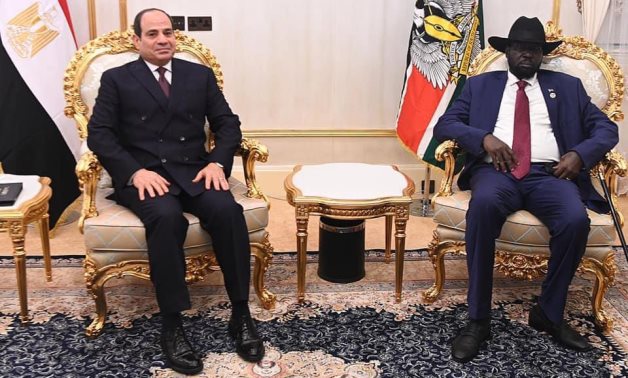
President Abdel Fatah al-Sisi and his South Sudanese counterpart Salva Kiir in a meeting in Juba on November 28, 2020. Press Photo
CAIRO – 28 November 2020: President Abdel Fatah al-Sisi and his South Sudanese counterpart Salva Kiir discussed in Juba on Saturday the developments of negotiations on the Grand Ethiopian Renaissance Dam (GERD).
Both leaders shared the same viewpoint of the necessity for Egypt, Ethiopia, and Sudan to conclude a legal binding agreement on the operation and filling of GERD. They also congrued on the importance of strengthening cooperation among Nile Basin countries in a way that achieves their mutual interests and does not harm any state.
President Sisi headed Saturday to the South Sudanese capital, Juba, to meet his counterpart Salva Kiir.
Presidency Spokesperson Ambassador Bassam Rady pointed out that Sisi's first visit to South Sudan is aimed at discussing joint cooperation between both countries, and ways of strengthening bilateral relations, particularly on the economic and developmental levels.
Both leaders will also confer over key political developments in the region and Africa.
The controversial Grand Ethiopian Renaissance Dam (GERD) will start the first round of power generation in June 2021, Ethiopian Fana Broadcasting Corporate S.C reported Ethiopian Minister of Water, Irrigation and Energy Seleshi Bekele on Thursday.
“In June 2021, the dam will start its first round of power generation,” he said during an online lecture at the University College London (UCL).
The Ethiopian announcement of generating power comes amid rejection by the other Nile downstream countries [Egypt and Sudan]. Four days ago, Sudanese Prime Minister Abdullah Hamdok stated that the GERD directly affects his country, asserting that it must not be operated until an agreement is reached.
Earlier, Sudan decided not to participate in the tripartite meeting with Egypt and Ethiopia in the coming round of tripartite meetings.
The three countries have conducted several meetings under the brokerage of the African Union (AU) over the last few months, but they reached a stalemate every round they held on the technical and legal points of contention.
Late October, Egyptian Minister of Water Resources and Irrigation Mohamed Abdel-Atti in an interview with “From Cairo” T.V. program on Sky News Arabia said that Ethiopia is responsible for the failure of reaching a comprehensive agreement with the Nile downstream countries [Egypt and Sudan] regarding the operation and the filling of its dam.
The dispute between Egypt, Sudan, and Ethiopia dates back to May 2011 when Ethiopia started building the dam; Egypt voiced concern over its water share [55.5 billion cubic meters]. Three years later, a series of tripartite talks between the two countries along with Sudan began to reach an agreement, while Ethiopia continued the dam construction.
In 2015, the three countries signed the Declaration of Principles, per which the downstream countries should not be negatively affected by the construction of the dam. In October 2019, Egypt blamed Addis Ababa for hindering a final agreement concerning a technical problem, calling for activating Article No. 10 of the Declaration of Principles, which stipulates that if the three countries could not find a solution to these disputes, they have to ask for mediation.
Washington had brokered a tripartite discussion between the three countries, in presence of the President of the World Bank (WB) starting from November 6, 2019 until February 27 and 28, 2020 when Ethiopia apologized for being absent from the negotiations. During these rounds of talks, tangible outcomes were agreed on among the three parties concerning the rules and mechanism of operating the dam and the filling process of the reservoir during the drought and prolonged drought; however, the Ethiopian and Sudanese refused to sign the US/WB-drafted deal.
Constructions in the Grand Renaissance Dam started on April 2, 2011 at a cost of $4.8 billion. It was built by the Italian construction and engineering company Salini Impergilo. The Italian company is headquartered in Milan. The dam is located on the Blue Nile with a capacity of 74 billion cubic meters, and is expected to generate up to 6,000 megawatts of power.
Photos of President Sisi's reception in Juba



Comments
Leave a Comment